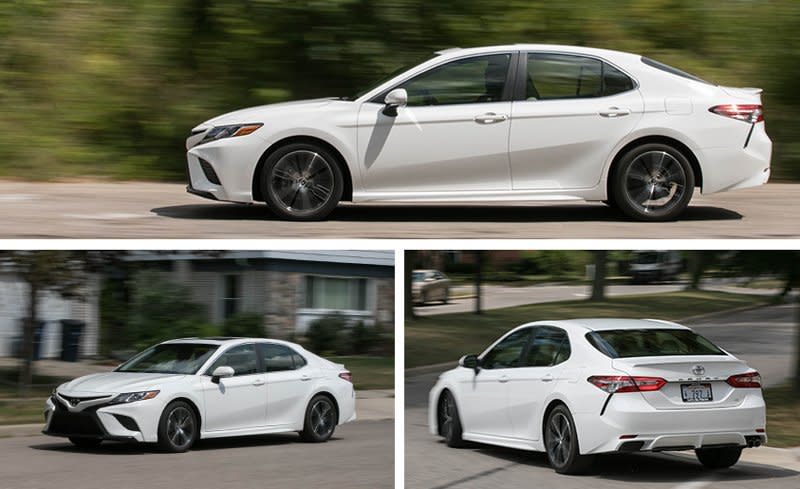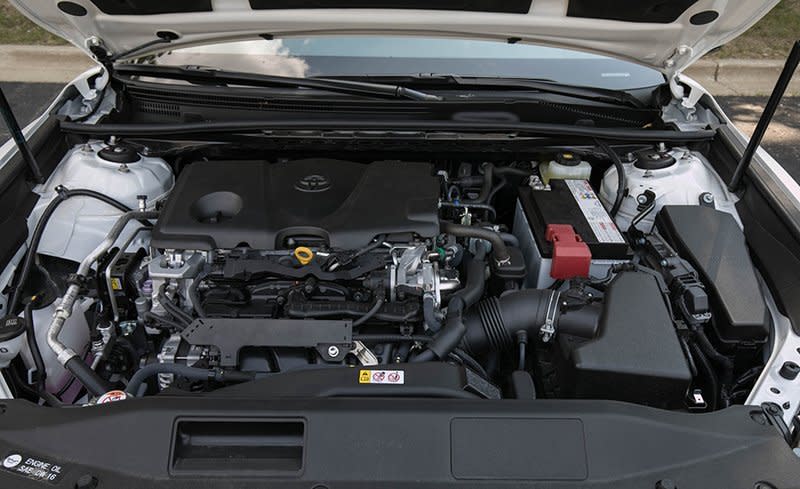2018 Toyota Camry SE 2.5L

Hell has frozen over and pigs are flying, as Toyota has done the seemingly improbable: build a Camry that, for once, isn’t a wallflower when it comes time to dance. After 16 years of riding on Toyota’s venerable K platform, the 2018 Toyota Camry moves the company’s mid-size family sedan onto the scalable Toyota New Global Architecture (TNGA) that also underpins the Prius hatchback and the C-HR subcompact crossover and which will serve as the basis for the next-generation Avalon, Corolla, and Highlander.
Lower and wider than its predecessor, the new Camry boasts a 30 percent improvement in torsional rigidity over the previous car. Whereas the prior Camry SE clomped and crashed over bumps, the eighth-generation model quietly glides over road irregularities. Notably, it does so without sacrificing roll stiffness or lateral grip.

In fact, this 2018 Camry SE managed to circle our 300-foot skidpad at an impressive 0.88 g wearing a set of Hankook Kinergy GT all-season tires. Thanks to the predictable and composed attitude of the chassis, as well as the responsive and well-weighted electrically assisted power steering, the Camry SE encourages its driver to take advantage of its relatively lofty lateral limits.
Power Hour
Every 2018 Camry—from the base L, to the mid-level LE and SE, and all the way up to the top-of-the-line XLE and XSE—comes standard with a 2.5-liter inline-four paired with an eight-speed automatic transmission. Armed with 203 horsepower and 184 lb-ft of torque (206 horsepower and 186 lb-ft in the quad-exhaust XSE model), the Camry’s all-new four-cylinder produces an additional 25 horsepower and 14 lb-ft of torque compared with its predecessor.
The new four-cylinder Camry is also considerably more economical than the previous-generation car, with EPA fuel-economy figures that climb by 4 mpg in the city (to 28 mpg), by 6 mpg on the highway (to 39), and by 5 mpg overall (to 32 mpg combined). We matched that combined figure over the course of 1452 miles. Even more impressive was the Camry SE’s 45-mpg showing on our 75-mph highway fuel-economy run, which is 1 mpg better than that of the Camry hybrid.

The four-cylinder’s straight-line performance was less rousing. Zero to 60 mph required 7.9 seconds, just 0.1 second ahead of the old car. Meanwhile, the new Camry’s slow-to-downshift automatic transmission contributed to a 50-to-70-mph passing time of 6.0 seconds, 0.4 second worse than the previous-generation Camry SE and 1.4 seconds behind the Mazda 6.
Like its predecessor, the 2018 Camry SE also is available with a gasoline-electric hybrid powertrain or a 3.5-liter V-6. The former option produces a combined 208 horsepower and managed to scoot from zero to 60 mph in 7.9 seconds and from 50 to 70 mph in 5.1 seconds. We’ve yet to test a V-6 car, but we expect the 301-hp engine to get the Camry to 60 mph in less than 6.0 seconds.
It’s a Cruiser Not a Bruiser
Even though the 2018 Camry’s more engaging persona has transformed it into a competent driving companion, at heart it remains, well, a Camry. Thanks to a wheelbase that has been stretched 1.9 inches, overall passenger space is up by 2 cubic feet, although rear legroom is down by 0.9 inch. Still, only NBA-size passengers will notice the loss in legroom, as the Camry’s aft quarters remain plenty spacious. The supportive and well-padded rear bench has a 60/40 split-folding seatback (except on the base L). But the pass-through is relatively small, and it’s further compromised by the seatbacks’ inability to lie completely flat.

Up front, the driver is greeted with a dashboard that features clearly marked gauges, easy-to-reach controls, and rich materials. Cost cutting, however, is apparent on the center console and door panels, which feature harder plastics. Shutting this Camry SE’s doors resulted in a disappointingly hollow sound unbecoming of a vehicle with a starting price of $26,095. Other demerits include Toyota’s decision to equip the Camry SE with just one USB port (the $29,345 XLE and the $29,895 XSE both come with three), as well as a lack of Apple CarPlay or Android Auto compatibility, which are unavailable on any Toyota.
Priced to Sell
Like the entry-level $24,380 Camry L and the $24,895 Camry LE, the Camry SE comes standard with LED headlights and taillights, a 7.0-inch touchscreen infotainment system, steering-wheel-mounted audio controls, adaptive cruise control, lane-departure warning, lane-keeping assist, automatic high-beams, and automated emergency braking.
The SE adds automatic climate control, cloth-and-faux-leather seats with power adjustability for the driver, and a leather-trimmed steering wheel with paddle shifters. SE models also include their own special dash trim, 18-inch wheels, a tacky-looking exterior kit that features a decklid spoiler and fake vents below the taillights, and an odd striped pattern on the seat inserts that doesn’t give off an upscale vibe. We’d take a hard look at stepping up to the better-equipped XSE or XLE model, which substantially improves the perceived quality of the interior.

Our $28,220 test car featured the optional sunroof ($900) and the $1225 Convenience package, which includes a proximity key with push-button start, an automatically dimming rearview mirror, and a blind-spot monitoring system. An in-dash navigation system and dual-zone automatic climate control are available as part of a $2480 bundle that also includes the contents of the Convenience package.
Although family-sedan shoppers who prize driving engagement will be better served by a Honda Accord or a Mazda 6, choosing a Camry no longer means forsaking satisfying driving dynamics. Pinch us, we must be dreaming.
Specifications >
VEHICLE TYPE: front-engine, front-wheel-drive, 5-passenger, 4-door sedan
PRICE AS TESTED: $28,220 (base price: $26,095)
ENGINE TYPE: DOHC 16-valve Atkinson-capable inline-4, aluminum block and head, port and direct fuel injection
Displacement: 152 cu in, 2487 cc
Power: 203 hp @ 6600 rpm
Torque: 184 lb-ft @ 5000 rpm
TRANSMISSION: 8-speed automatic with manual shifting mode
DIMENSIONS:
Wheelbase: 111.2 in
Length: 192.7 in
Width: 72.4 in Height: 56.9 in
Passenger volume: 100 cu ft
Trunk volume: 15 cu ft
Curb weight: 3409 lb
C/D TEST RESULTS:
Zero to 60 mph: 7.9 sec
Zero to 100 mph: 20.5 sec
Zero to 120 mph: 32.0 sec
Rolling start, 5–60 mph: 8.2 sec
Top gear, 30–50 mph: 4.3 sec
Top gear, 50–70 mph: 6.0 sec
Standing ¼-mile: 16.2 sec @ 90 mph
Top speed (governor limited): 133 mph
Braking, 70–0 mph: 175 ft
Roadholding, 300-ft-dia skidpad: 0.88 g
C/D FUEL ECONOMY:
Observed: 32 MPG
75-mph highway driving: 45 mpg
Highway range: 720 miles
EPA FUEL ECONOMY:
Combined/city/highway: 32/28/39 mpg

 Yahoo Autos
Yahoo Autos 